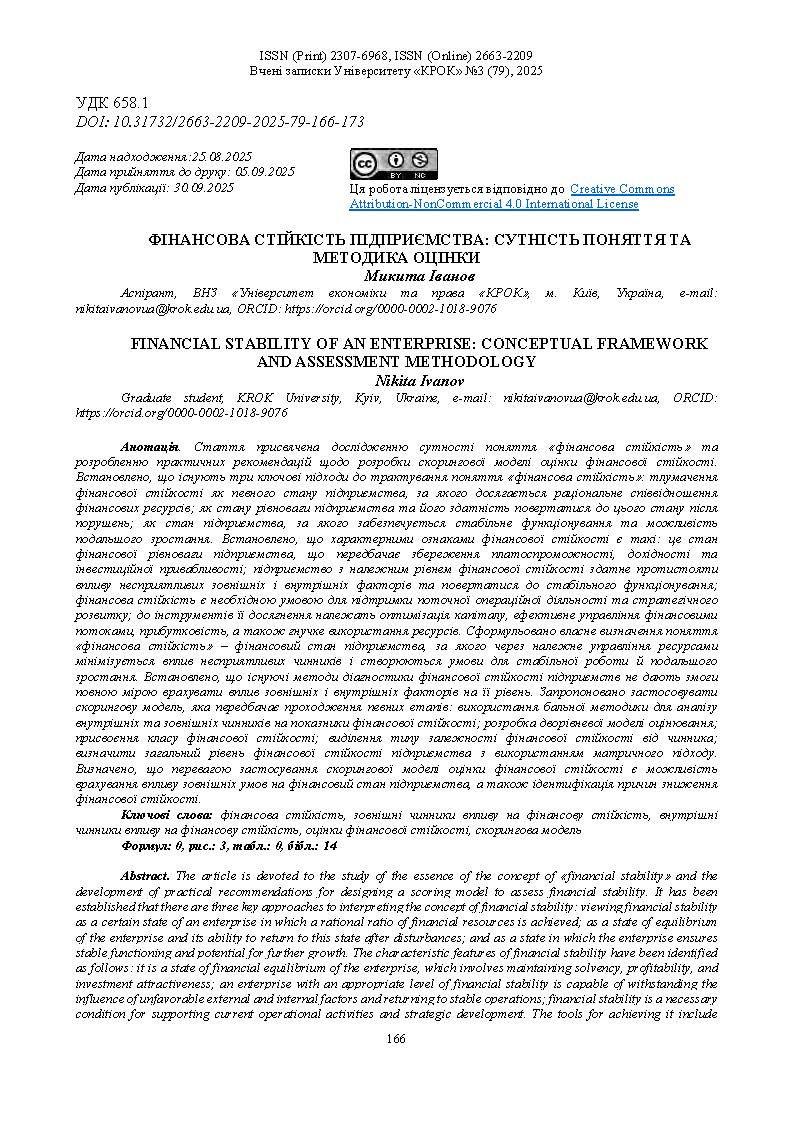FINANCIAL STABILITY OF AN ENTERPRISE: CONCEPTUAL FRAMEWORK AND ASSESSMENT METHODOLOGY
DOI:
https://doi.org/10.31732/2663-2209-2025-79-166-173Keywords:
financial stability, external factors influencing financial stability, internal factors influencing financial stability, financial stability assessment, scoring modelAbstract
The article is devoted to the study of the essence of the concept of «financial stability» and the development of practical recommendations for designing a scoring model to assess financial stability. It has been established that there are three key approaches to interpreting the concept of financial stability: viewing financial stability as a certain state of an enterprise in which a rational ratio of financial resources is achieved; as a state of equilibrium of the enterprise and its ability to return to this state after disturbances; and as a state in which the enterprise ensures stable functioning and potential for further growth. The characteristic features of financial stability have been identified as follows: it is a state of financial equilibrium of the enterprise, which involves maintaining solvency, profitability, and investment attractiveness; an enterprise with an appropriate level of financial stability is capable of withstanding the influence of unfavorable external and internal factors and returning to stable operations; financial stability is a necessary condition for supporting current operational activities and strategic development. The tools for achieving it include capital optimization, effective management of financial flows, profitability, and flexible use of resources. A new definition of the concept of «financial stability» is proposed: a financial condition of an enterprise in which, through proper resource management, the impact of adverse factors is minimized and conditions are created for stable operations and further growth. It has been established that the existing methods for diagnosing the financial stability of enterprises do not fully account for the impact of external and internal factors on its level. It is proposed to use a scoring model, which involves several stages: applying a point-based methodology to analyze internal and external factors affecting financial stability indicators; developing a two-level evaluation model; assigning a financial stability class; identifying the type of dependency of financial stability on a specific factor; and determining the overall level of financial stability of the enterprise using a matrix approach. It has been determined that the advantage of using a scoring model to assess financial stability lies in its ability to consider the influence of external conditions on the financial state of the enterprise, as well as to identify the causes of decreased financial stability.
Downloads
References
Базілінська О.Я. & Панченко О.І. (2019). Фінансова стійкість у системі стратегічного управління підприємством. Проблеми економіки. № 1 (39). 89-94. DOI: 10.32983/2222-0712-2019-1-89-94
Василенко А.В. (2015). Менеджмент стійкого розвитку підприємства: монографія. Київ: Центр учбової літератури, 648 с.
Журавльова О.Є. (2009). Фінансова стійкість підприємства: теорія і практика. Формування ринкової економіки. № 22. 523-526.
Колодізєв О.М. (2017). Дослідження сутності та змісту економічної стійкості підприємства. Наук.-техн. зб.: Комунальне господарство міст. № 78. 238-243
Кравченко М. О. & Леонтовська М. А. (2022). Підходи до оцінювання фінансової стійкості інноваційно-активних підприємств. Економічний вісник НТУУ «Київський політехнічний інститут». №24. 93-99
Лахтіонова Л.А. (2013). Аналіз фінансової стійкості суб’єктів підприємницької діяльності : монографія. Київ : Знання України. 1091 с.
Лобода О. М. & Кириченко Н. В. (2023) Методика оцінки фінансової стійкості підприємства за допомогою економіко-статистичного аналізу. Таврiйський науковий вiсник. Серiя: Eкoноміка». Вип. 18. 114-121. DOI: https://doi.org/10.32782/2708-0366/2023.18.12
Островська О.А. (2012). Фінансовий стан та фінансова стійкість підприємств: теоретичні аспекти визначення їх суті. Стратегія економічного розвитку України. Вип. 4 (11). 18-186.
Плиса В.Й. & Приймак І.І. (2009). Стратегія забезпечення фінансової стійкості суб’єктів господарювання в економіці України: монографія. Львів : АТБ, 142 с.
Румик, І., Плетенецька, С., & Царенок, О. (2023). Особливості управління фінансовими ресурсами підприємств в умовах воєнного стану. Вчені записки Університету «КРОК», (4(72), 9–19. https://doi.org/10.31732/2663-2209-2023-72-9-19
Румик, І., & Пилипенко, О. (2022). Фінансове забезпечення підприємств: можливості використання когнітивного моделювання. Вчені записки Університету «КРОК», (2(66), 44–52. https://doi.org/10.31732/2663-2209-2022-66-44-52
Сітак І.Л. & Мурашко І.М. (2019). Характеристика методик оцінки економічної стійкості підприємств. Теорія та методологія формування інвестиційно-фінансової стратегії розвитку суб'єктів національного господарства : монографія Дніпро : Журфонд. 270-285.
Тютюнник Ю.М. & Литвиненко А.М. (2015). Оцінювання оптимальності співвідношення власного й позикового капіталу. Доступ через: http://archive.nbuv.gov.ua.
Юдіна С.В., Галаганов В.О. & Стребіж М.О. (2023). Методичний підхід до управління фінансовою стійкістю підприємства. Економічний простір. № 187. 178-183. DOI: 10.32782/2224-6282/187-29

Downloads
Published
How to Cite
Issue
Section
License

This work is licensed under a Creative Commons Attribution-NonCommercial 4.0 International License.

